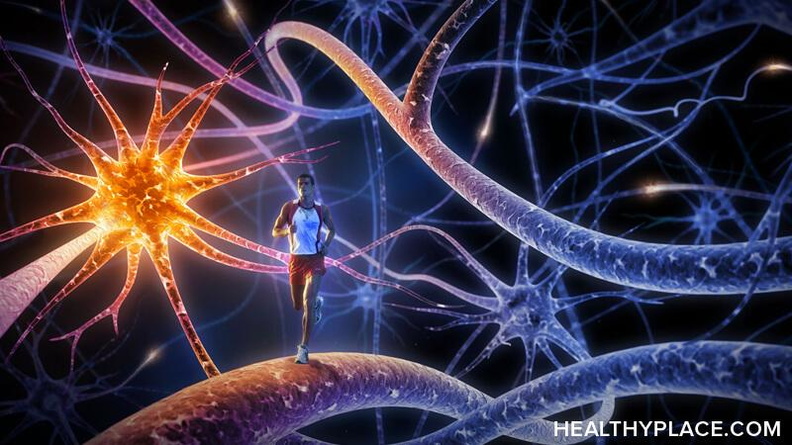Treating Depression and Bipolar Disorder Without Drugs

A thorough discussion of alternative treatments for depression and bipolar disorder including lifestyle changes, EMDR, neurofeedback, and amino acid supplements.
Over the past 50 years, psychiatric drugs have become the major tools for treating mental illness. The first tranquilizers, introduced in 1952, have been followed nearly every decade since by a new class of drugs, the latest being antidepressants. While drugs were a godsend compared to the standard (and now seemingly barbaric) therapies of the 1930s—induced insulin coma, electroshock, and lobotomy—their shortcomings and dangers have become increasingly clear.
Fifty percent of depressed and bipolar patients experience no improvement with antidepressants. Of those who find relief, half go off their "meds" because of the unbearable side effects: Psychiatric drugs often cause a 30- to 60-pound weight gain, 58 percent report some level of sexual dysfunction, 40 percent develop tics or muscle spasms from major tranquilizers, and significant numbers report increased agitation, depression, mania, or suicidal urges. Other unadvertised, potential dangers include increased risk of non-Hodgkin's lymphoma, invasive ovarian cancer, and lung and bladder cancers; doubled risk of heart attack; elevated risk for developing Type 2 diabetes; and, in children, increased mania, suicide, and stunted or delayed growth.
And yet in the face of this prescription onslaught, mounting evidence indicates that depression, bipolar, and other mood disorders are caused by a combination of genetic, environmental, and lifestyle factors. While there's not much anyone can do to alter the genes they've inherited, holistic approaches to the other two factors can lead to safer ways of managing these conditions.
Rule out Underlying Causes
Finding relief from the symptoms associated with mood disorders is a process that starts with addressing various physical issues. The biggest step many of us can take toward mental health involves getting our bodies into the best shape possible. This requires skilled sleuthing by the patient and experienced practitioners. The goal? To identify and eliminate common underlying causes of mental illness, such as environmental toxins, medications, diseases, low or imbalanced hormones, food allergies, parasites, and candida yeast.
- Get a complete physical, and ask your healthcare provider to review all your prescriptions and any illnesses you may have for mood disorder side effects. Order some or all of the tests below, using the knowledge of your history and symptoms to gauge which of them will most likely identify potential culprits.
- Make sure you're taking the basics. These include high potency vitamin, mineral, and amino acid supplements (see below) and fish oils to ensure the brain has adequate supplies of the raw materials it needs to function properly and override genetic errors or digestive flaws.
- Avoid unhealthy foods and lifestyle choices. Start by eliminating the "bad" fats. Fried foods, hydrogenated oils, and trans fats clog up the body's intricate systems and contribute to systemic inflammation. Replace these bad actors with the "good" fats required for health, such as fish, olive, vegetable, nut, and seed oils.
- Cut out any and all substances that affect your mind. This may sound like a no-brainer, but stop using street drugs, alcohol, and tobacco, and either cut way back or eliminate caffeine, refined sugar, chocolate, artificial sweeteners, and monosodium glutamate.
Some mood disorders, those triggered by emotional trauma or produced by abnormal brain-wave patterns, remain immune to biological remedies. However, two nondrug therapies, Eye Movement Desensitization & Reprocessing (EMDR) and neurofeedback have shown remarkable rates of success.
The Eyes Have It
Traumatic experiences, such as rape, sexual or physical abuse, war experiences, or being the victim of a violent crime or terrifying accident may cause post-traumatic stress disorder (PTSD). Symptoms may include depression, anxiety attacks, rage or aggressive behavior, suicidal tendencies, substance abuse, terrifying nightmares, and visual flashbacks in which the person re-experiences some of the emotions and sensations from the original trauma.
Francine Shapiro, PhD, a senior research fellow at the Mental Research Institute in Palo Alto, California, developed EMDR after she noticed her own stress reactions diminish when her eyes swept back and forth while walking through a park. During treatment, a therapist asks patients to identify a vivid visual image related to the incident, along with related emotions and body sensations. While focusing on the image, negative thoughts, or sensations, patients simultaneously move their eyes back and forth, following the therapist's fingers across their field of vision, for 20 to 30 seconds.
Patients are next told to "let their mind go," observing whatever thought, feeling, image, memory, or sensation surfaces. The therapist helps them "process the association"—and deal with any distress the images may cause—before moving on to the next focus. The primary objective is to "reprogram" the emotional brain so it stops continuing to react based on past experiences.
In 2002, The Journal of Clinical Psychology reported that 70 percent of EMDR participants achieved results in three active treatment sessions. It is one of four therapies given the highest recommendation by the US Department of Veterans Affairs guidelines for PTSD.
Retraining Brain Waves
D. Corydon Hammond, PhD, professor and psychologist at the University of Utah School of Medicine, says neuroscientists have discovered a brain-wave pattern that identifies people with a "biological predisposition for developing depression." An excess of slow alpha brain-wave activity in the left frontal area of the brain signals this predisposition. According to Hammond, research has found that antidepressants have only an 18 percent effect over and above a placebo and appear "to still leave intact the biological predisposition for becoming more easily depressed." By retraining the brain, it is possible to produce an enduring change.
Using electroencephalograms (EEGs) to measure brain-wave activity, neurofeedback teaches patients how to alter the flow of electrical impulses in their brains. The patient sits in front of a computer screen that's connected to a very small EEG recorder, which registers brain-wave patterns via electrodes pasted to the patient's scalp. The therapist uses computer readings to assess "normal" or "abnormal" levels of brain waves at any frequency and sets up a program that rewards desirable frequencies and discourages damaging ones with sounds and visuals.
Learning to control the mind and giving the body a clean bill of health can help people with mood disorders avoid an often life-long reliance on psychiatric drugs—and save them from the damage those pharmaceutical can wreak havoc on mind and body alike.
Amino Acid Supplements
Check with your practitioner (or therapist) about taking the following between meals (without food):
- Tryptophan (sold as 5-Http), 50 to 150 mg for depression, stress, and to curb carbohydrate cravings.
- Tyrosine or Phenylalanine (or a combo, since tyrosine is made from phenylalanine), 500 mg two or three times a day (too much can trigger mania) to lift depression, aid in stress management, promote memory, and suppress appetite.
- GABA, 500 mg as needed to calm down or for sleep (sometimes blended with taurine and glycine for calming).
- Glutamine, 1,000 mg three times a day to make more GABA and to promote intelligence or memory while healing leaky gut and reducing alcohol or sugar cravings.
- Methionine, 500 mg twice a day to lower blood histamine, which, when elevated, contributes to mania and anxiety.
- Cysteine and cystine, methionine, and glutamic acid, all of which are sulfur-containing amino acids that aid in detoxification.
- Taurine, methionine, and glutamine to improve fat digestion and absorption of fat-soluble vitamins.
- Balanced amino acids. If you are a vegan, vegetarian, or do not like or digest protein well, try taking a balanced amino acid formulation.
Making Mental Waves
The four types of brain waves linked to mood disorders—beta, SMR (sensorimotor rhythm), alpha, and theta—correspond to different problems and conditions.
-
Beta waves (15-18 Hz) occur when fully awake, with eyes open and our concentration fixed on something. Considered a measure of arousal, higher frequencies (21-30 Hz) indicate anxiety and obsessions. Therapists often reward beta-wave activity to relieve depression or to improve concentration in individuals with ADHD.
-
SMR waves (12-15 Hz) indicate calm attention with physical inactivity. Hyperactive children learn to calm down by increasing their ability to generate SMR waves.
-
Alpha waves (8-12 Hz), when recorded with eyes closed, are an indicator of relaxed wakefulness and meditative states. Excessive alpha activity on the left side of the brain may indicate depression. Treatment focuses on reducing left frontal alpha wave activity while increasing left frontal beta wave activity.
-
Theta waves (4-7 Hz) are associated with light, healthy sleep. Although the normal adult produces no theta rhythm while awake, these frequencies are important in infancy, childhood, and young adults, and they indicate pleasure. Children with concentration problems often have excessive theta activity in the front of their brains. They appear awake in class, trying to concentrate, but their brain is literally half-asleep. Neurofeedback corrects this by teaching the child how to reduce theta waves.
Emotional Transformation Therapy (ETT) is a new accelerated form of psychotherapy developed by Steven Vazquez, PhD, a practicing therapist for 25 years. It combines the use of colored lights, eye movement and stimulation, and brain-wave entrainment with psychotherapy for rapid relief of depression, anxiety, PTSD, and physical pain. Relatively new, the best source of information on ETT is www.lightworkassociates.com.
About the author: Gracelyn Guyol is the author of Healing Depression & Bipolar Disorder Without Drugs. The book features Gracelyn's own story and those of thirteen other people around the country who have cured their depression and bipolar disorder using only natural therapies. In-depth research and the expertise of alternative health-care professionals are included in this landmark guide for patients and caregivers seeking responsible, safe alternatives to psychiatric drugs.
Source: Alternative Medicine
APA Reference
Staff, H.
(2008, October 21). Treating Depression and Bipolar Disorder Without Drugs, HealthyPlace. Retrieved
on 2026, January 7 from https://www.healthyplace.com/alternative-mental-health/bipolar-medicine/treating-depression-and-bipolar-disorder-without-drugs

